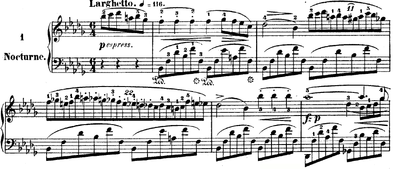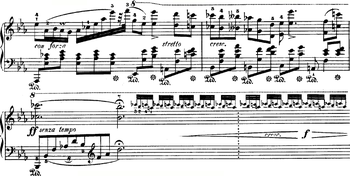Nocturnes, Op. 9 (Chopin)

The Nocturnes, Op. 9 are a set of three nocturnes written by Frédéric Chopin between 1830 and 1832, published that year, and dedicated to Madame Camille Pleyel. The second nocturne of the work is widely regarded as Chopin's most famous piece, and is regularly featured in films, television programs and video games.[1][2]
Nocturne in B-flat minor, Op. 9, No. 1

This nocturne has a rhythmic freedom that came to characterise Chopin's later work. The left hand has an unbroken sequence of eighth notes in simple arpeggios throughout the entire piece, while the right hand moves with freedom in patterns of seven, eleven, twenty, and twenty-two notes.
The opening section moves into a contrasting middle section, which flows back to the opening material in a transitional passage where the melody floats above seventeen consecutive bars of D-flat major chords. The reprise of the first section grows out of this and the nocturne concludes peacefully with a Picardy third.
Nocturne in E-flat major, Op. 9, No. 2
Chopin composed his most popular Nocturne in E-flat major, Op. 9, No. 2 when he was about twenty.
This popular nocturne is in rounded binary form (A, A, B, A, B, A) with coda, C. The A and B sections become increasingly ornamented with each recurrence. The penultimate bar utilizes considerable rhythmic freedom, indicated by the instruction, senza tempo (without tempo). Nocturne in E-flat major opens with a legato melody, mostly played piano, containing graceful upward leaps which becomes increasingly wide as the line unfolds. This melody is heard again three times during the piece. With each repetition, it is varied by ever more elaborate decorative tones and trills. The nocturne also includes a subordinate melody, which is played with rubato.
A sonorous foundation for the melodic line is provided by the widely spaced notes in the accompaniment, connected by the damper pedal. The waltz-like accompaniment gently emphasizes the 12/8 meter, 12 beats to the measure subdivided into four groups of 3 beats each.
The nocturne is reflective in mood until it suddenly becomes passionate near the end. The new concluding melody begins softly but then ascends to a high register and is played forcefully in octaves, eventually reaching the loudest part of the piece, marked fortissimo. After a trill-like passage, the excitement subsides; the nocturne ends calmly.
 |
 |
Analysis
- John Rink "Structural momentum and closure in Chopin's Nocturne Op 9 No 2" in Schenker Studies 2 (ed. Carl Schachter, Hedi Siegel) pp102–127 Cambridge University Press, 2006 ISBN 0-521-02832-9, ISBN 978-0-521-02832-5.
- Jean-Jacques Eigeldinger "Nocturne op. 9/2, E flat major" in Chopin: pianist and teacher as seen by his pupils (ed. Jean-Jacques Eigeldinger, Roy Howat) pp77–79 Cambridge University Press, 1989 ISBN 0-521-36709-3, ISBN 978-0-521-36709-7.
- Eleanor Bailie "Nocturne No. 2 in E flat major" in Chopin: a graded practical guide (Eleanor Bailie, Issue 3 of The pianist's repertoire) pp303–306 Kahn & Averill, 1998 ISBN 1-871082-67-6, ISBN 978-1-871082-67-8.
In popular culture
- Bones (2009) In season 5 episode 3, The Plain in the Prodigy: Amish boy Levi playing his audition piece; repeats as Levi's parents watch the video.
- 127 Hours (2010)[3] The scene begins some years earlier in family home with Aron's younger sister rehearsing Nocturnes, Op.9, No. 2. After several days of being pinned by a boulder, Aron Ralston (James Franco), dehydrated, delusional, and believing he is going to die, reminisces his past to the bliss of Nocturne.
- The Raven (2012) Alice Eve's character, Emily, plays Nocturnes Op. 9, No. 2, to an audience as her father converses with Inspector Fields.
- Mad Men (2013) Played on violin by Sandy in the Season 6 premiere "The Doorway"
- Bad Santa (2003) Played at the opening of the film with Billy Bob Thornton's character narrating over it.
- The Purge: Anarchy (2014) Played by a pianist at the auction.
- BioShock Infinite (2013) Played on radios throughout the Finkton Docks area of Columbia.
- Hetalia Axis Powers (2007) Played by Austria in Episode 06.
- Parasyte -the maxim- (2014-2015) Played in its entirety in episode 15 of the anime adaptation.
- Dexter (TV series) (2007) In season 2 episode 7, That Night, a Forest Grew, listened to on headphones while working out by Debra Morgan, at the suggestion of FBI Special Agent Frank Lundy.
- Hannibal (TV series) (2013) In season 1 episode 4, played while Hannibal was having dinner with Jack.
- American Horror Story: Coven (2013) In the opening of the episode "Go To Hell," the song plays as Fiona explains to Queenie what the Seven Wonders are.
- Fallout 4 (2015) Played on the game's Classical Radio station.
- The Simpsons (2014) In the Season 26 premiere's Couch Gag created by Academy Award-nominated surrealist animator Don Hertzfeldt, as a deformed Homer Simpson of the year 10,535 reminisces through the millennia of how his family wasn't so deformed and could still communicate with each other, Nocturnes Op. 9, No. 2, is played in the background, when his family tried telling him that they were still a loving family and would not forget him as the millennia passed on and the series became more dependent on shock humor, non sequiturs and merchandise schilling that through time the family would become more deformed and ultimately forget him.[4]
In popular music
Muse's "Collateral Damage" is the same as Nocturne Op. 9 No. 2 in Eb, with slight modifications, a handful of changed notes, an added string section, children's laughter and jet fighters;[5] this song is used as an ending to the song "United States of Eurasia".
Nocturne in B major, Op. 9, No. 3

It is in ternary form A-B-A. The first section is marked allegretto. The main theme is chromatic, but filled with nostalgic energy. The second contrasting section, Agitato in B minor, is a very dramatic one with a combined melody and counter-melody in the right hand and continuous 8th note arpeggios in the left, which requires an amount of virtuosity. The piece is full of coloratura ornaments, and ends with a wide chord in the left hand accompanied with right hand triplets in a high octave to lead to a legatissimo smorzando adagio (senza tempo).[further explanation needed]
References
- ^ Johnston, Blair. "Nocturnes (3) for piano, Op. 9".
- ^ "Frédéric Chopin (Soundtrack)". IMDb. Retrieved 28 February 2014.
- ^ "127 Hours Original Motion Picture Soundtrack". soundtrack-movie.com. October 29, 2010. Retrieved 2011-06-06.
- ^ Animation Domination (September 29, 2014). "THE SIMPSONS | Couch Gag from "Clown In The Dumps" | ANIMATION on FOX". YouTube. Retrieved January 9, 2016.
- ^ David Raposa (August 3, 2009). "Muse - "United States of Eurasia / Collateral Damage"". Pitchfork. Retrieved 2011-07-14.
External links
- Nocturnes Op. 9: Scores at the International Music Score Library Project
- Free sheet music of the Nocturnes, on Cantorion.org
- Nocturnes, Op. 9 (Chopin) at the Mutopia Project.
- Hear the performance of the Op. 9 No. 2 Nocturne with original cadenzas at The Chopin Project

